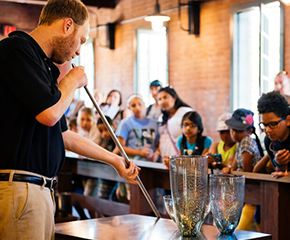1899 Duryea Trap
Add to SetSummary
Cars of this era usually looked like squarish horse-drawn buggies. But Charles Duryea was inspired by the more graceful curves of a victoria carriage. The curling front forks support the single front wheel and flex to absorb jolts. The driver used a control stick to steer, shift gears, and accelerate. The automobile may have looked good, but passengers sat back to back, making conversation difficult.
Cars of this era usually looked like squarish horse-drawn buggies. But Charles Duryea was inspired by the more graceful curves of a victoria carriage. The curling front forks support the single front wheel and flex to absorb jolts. The driver used a control stick to steer, shift gears, and accelerate. The automobile may have looked good, but passengers sat back to back, making conversation difficult.
Artifact
Automobile
Date Made
1899
Creators
Place of Creation
United States, Illinois, Peoria
Creator Notes
Made by Duryea Motor Wagon Company in Peoria, Illinois.

On Exhibit
at Henry Ford Museum in Driving America
Object ID
36.110.1
Credit
From the Collections of The Henry Ford.
Material
Metal
Wood (Plant material)
Leather
Color
Black (Color)
Blue
Red
Yellow (Color)
Dimensions
Height: 51 in
Width: 62 in
Length: 101.5 in
Specifications
Make & Model: 1899 Duryea trap
Maker: Duryea Manufacturing Company, Peoria, Illinois
Engine: inline-3, 215 cubic inches
Transmission: 2-speed manual
Height: 51 inches
Wheelbase: 66 inches
Width: 62 inches
Overall length: 102 inches
Weight: 700 pounds
Horsepower: 6
Pounds per horsepower: 116.7
Price: $1,200
Average 1899 wage: $426 per year
Time you'd work to buy this car: about 2 years, 10 months





